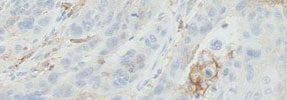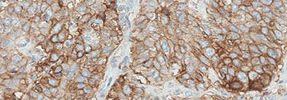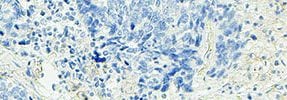Online Atlas of Stains for NSCLC: PD-L1 IHC 22C3 pharmDx

PD-L1 testing is an integral part of patient care, making your expertise in diagnostic assessment more important than ever. Use the Atlas of Stains to increase your familiarity and confidence in scoring NSCLC specimens stained with PD-L1 IHC 22C3 pharmDx. Tumor Proportion Score (TPS) is the scoring method used for defining
PD-L1 expression in NSCLC specimens.
The Atlas of Stains for NSCLC is a digital repository of NSCLC tissue samples stained with PD-L1 IHC 22C3 pharmDx including:
- Positive cases that span the full range of PD-L1 expression
- Negative cases that may demonstrate intrinsic controls (tumor-associated macrophages and immune cell staining)
- Full specimen staining with H&E, Negative Control Reagent (NCR), and primary antibody for each patient
The viewer interface for the Atlas of Stains for NSCLC features:
- High-definition, zoomable scans with full-screen and quadrant-view functionality for detailed PD-L1 stain analysis
- Expert annotations describing areas of interest plus the ability to add your own annotations
- TPS for each stain, to verify your own assessment
Intended Use
For in vitro diagnostic use.
PD-L1 IHC 22C3 pharmDx is a qualitative immunohistochemical assay using Monoclonal Mouse Anti-PD-L1, Clone 22C3 intended for use in the detection of PD-L1 protein in formalin-fixed, paraffin-embedded (FFPE) non-small cell lung cancer (NSCLC) and urothelial carcinoma tissues using EnVision FLEX visualization system on Autostainer Link 48.
Non-Small Cell Lung Cancer (NSCLC) PD-L1 protein expression in NSCLC is determined by using Tumor Proportion Score (TPS), which is the percentage of viable tumor cells showing partial or complete membrane staining at any intensity. The specimen should be considered to have PD-L1 expression if TPS ≥ 1% and high PD-L1 expression if TPS ≥ 50%.
PD-L1 IHC 22C3 pharmDx is indicated as an aid in identifying NSCLC patients for treatment with KEYTRUDA® (pembrolizumab). See the KEYTRUDA® product label for expression cutoff values guiding therapy in specific clinical circumstances.
Urothelial Carcinoma PD-L1 protein expression in urothelial carcinoma is determined by using Combined Positive Score (CPS), which is the number of PD-L1 staining cells (tumor cells, lymphocytes, macrophages) divided by the total number of viable tumor cells, multiplied by 100. The specimen should be considered to have PD-L1 expression if CPS ≥ 10.
PD-L1 IHC 22C3 pharmDx is indicated as an aid in identifying urothelial carcinoma patients for treatment with KEYTRUDA® (pembrolizumab). See the KEYTRUDA® product label for specific clinical circumstances guiding PD-L1 testing.
KEYTRUDA is a registered trademark of Merck Sharp & Dohme Corp., a subsidiary of Merck & Co., Inc.
For countries outside of the United States, see the local KEYTRUDA product label for approved indications and expression cutoff values to guide therapy.


